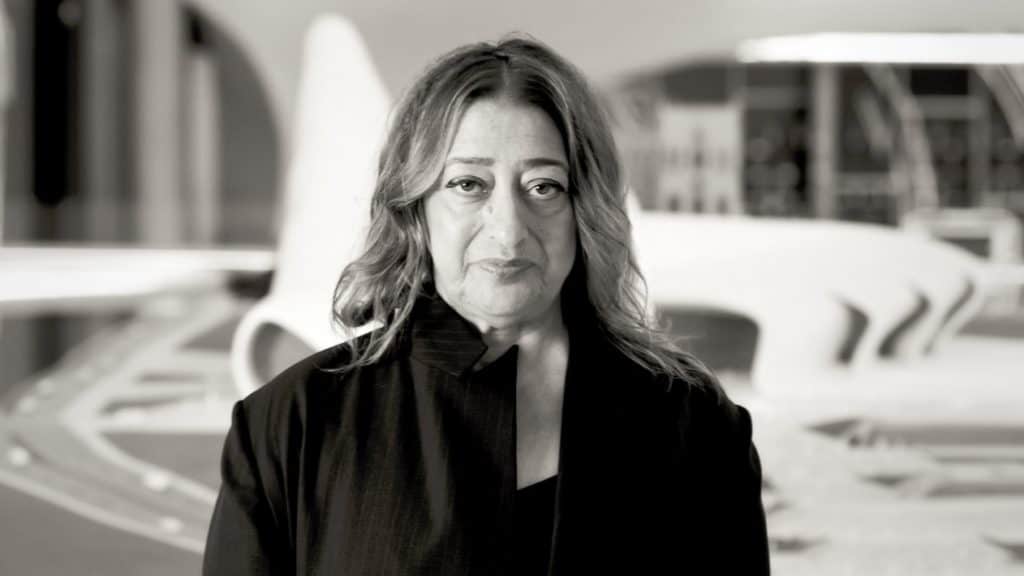Zaha Hadid was an award-winning and internationally recognized modern architect, professor, designer, and artist. In 2004 she was the first woman and Arab to receive the Pritzker Architecture Prize. Then, in 2010 and 2011, the Royal Institute of British Architects awarded Hadid the UK’s highly prestigious Stirling Prize.
In her early career, Hadid became known for her futuristic and outlandish ideas for building design. With a professional life spanning 1977 to 2016, she would design over 950 projects with her firm, Zaha Hadid Architects.
The Queen appointed Hadid Commander of the Order of the British Empire during her 2002 Birthday Honours. In the 2012 honours, Hadid became Dame Commander of the Order of the British Empire for her contributions to architecture.
Zaha Hadid Architects has continued Hadid’s work posthumously. Several of Hadid’s designs, including a Beijing airport and a New York City high-rise, opened after her death in 2016.
Zaha Hadid: Architect and Fashion Designer
Hadid began her career in after graduating from the Architectural Association School of Architecture school in the UK in 1977. She became a partner at the Office for Metropolitan Architecture in Rotterdam, the Netherlands. There, she worked with her former professors, architects Rem Koolhaas and Elia Zenghelis.
In 1980 Hadid opened her own firm, Zaha Hadid Architects, in London. She started to gain international recognition in 1988. Hadid was one of seven chosen architects to participate in Philip Johnson and Mark Wigley’s exhibition “Deconstructivism in Architecture” at the New York Museum of Modern Art.
In 1994, the architect completed one of her first and signature works, a fire station for the Swiss furniture company Vitra. The building, situated in the firm’s corporate headquarters in Weil am Rhein, Germany, later became an event venue.

Photo by Hélène Binet
Hadid’s most famous works include the Maxxi Museum in Rome (2009) and the Guangzhou Opera House in Guangzhou, China (2010). Her firm opened Azerbaijan’s cultural center—a $250 million project—in the country’s capital, Baku, in 2012.
“I understand when people say my buildings are extreme,” Hadid once told Official Bespoke Magazine. “They do not belong to this boxy kind of world that everyone’s used to. If they have become more extreme, it’s because [increasingly] they have had to accommodate so many different needs in a single solution.”
Hadid cited strong influence of the Russian avant-garde movement, particularly Malevich’s Suprematist Composition. She even reimagined the work as her school graduation project.

Zaha Hadid Foundation
“The spirit of adventure to embrace the new and the incredible belief in the power of invention attracted me to the Russian avant-garde,” said Hadid in her Pritzker acceptance speech.
Hadid began to teach architecture, beginning with her alma mater, the Architectural Association in the UK. She went on to lecture at prestigious schools including the Harvard Graduate School of Design, Yale, Cambridge University, and Columbia University.
Hadid also explored architectural design in fashion. She partnered with shoe and jewelry brands including the Denmark-based brand Georg Jensen and the L.A.-based company United Nude.
Zaha Hadid’s international childhood
Hadid was born in Baghdad, in the then-kingdom of Iraq, to a wealthy family in 1950. Her father, Muhammad al-Hajj Husayn Hadid, was an economist and Iraq’s Minister of Finance from 1958-1963. He also co-founded the al-Ahali liberal political group in 1932 and the National Democratic Party in 1946. Hadid’s family relocated to Beirut at the start of Saddam Hussein’s presidency.
The architect’s mother, Wajiha al-Sabunji, was an artist. Her brother Foulath was an accountant, writer, and Arab affairs expert. She is survived by her older brother Haytham.
Hadid pursued her interest in architecture and interior design beginning at age 11. Her mother encouraged Hadid’s interests by allowing her to design the guest room and her own bedroom.
As a child, Hadid attended a French-speaking Catholic school with a diverse Muslim, Jewish, and Catholic student body. She later studied mathematics as an undergraduate at the American University of Beirut.
In 1972, Hadid entered the Architectural Association School of Architecture in the UK, which was known for experimental design. It “ignited my ambition,” Hadid told the New York Times, and “taught me to trust even my strangest intuitions.”
Zaha Hadid Architects continues Hadid’s Legacy
Hadid died of a heart attack on March 31st, 2016 at 65 years old. The Mount Sinai Medical Center in Miami was treating her for bronchitis at the time. She is buried in Brookwood Cemetery in Surry, England, next to her father and brother.
At the time of her death, Hadid had several ongoing projects. Zaha Hadid Architects and partner firms continued these projects and opened them posthumously.
The New York-based firm Ismael Leyva Architects opened Hadid’s NYC luxury condo design in 2017. The 11-story luxury condo, 520 West 28th Street, sits along the city’s High Line. The building, which contains an IMAX theater and $50 million three-story penthouse, cost over $1 million to construct.
In 2019, Zaha Hadid Architects opened the Daxing International Airport in Beijing.
“People ask why are there no straight lines, why no 90 degree angles, well, life is not made in a grid,” Hadid said. “Now, it could be interesting at times to have a grid but if you think of a landscape, it’s not even, it’s not straight. People go to natural places and say it’s very relaxing. I think that one can achieve the same thing in architecture.”
The 2022 venue for the FIFA World Cup, the Al Janoub Stadium, also reached completion in 2019. The 40,000-seat stadium is located in Al Wakrah, Qatar.
In 2020, Hadid’s firm completed Miami’s new skyscraper, the One Thousand Museum. The residential tower is 62 stories and overlooks Biscayne National Park.
“You have to be very focused and work very hard,” Hadid told designboom, “but it is not about working hard without knowing what your aim is! You really have to have a goal. The goal posts might shift, but you should have a goal. Know what it is that you are trying to find out.”



